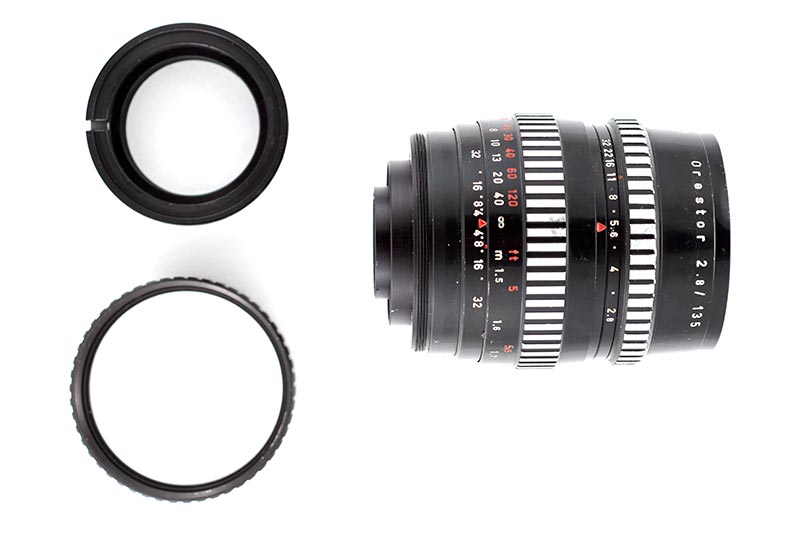Pekka Buttler 2/2023 (Updated 7/2025)
Introduction
Intermediate lens mounts are a subclass of lens mounts. One could say that they are not ‘proper’ lens mounts because there has never been a camera that would have natively accepted intermediate mount lenses. Instead, the point of intermediate mounts is that they:
• Have a long flange focal distance to make room for adapters, and
• They offer a wide range of adapters that allow the use of that lens on a broad range of lens mounts.

Meyer-Optik Görlitz Orestor with its adapter system allowing the adapting of MOG’s longer lenses to m42, Exakta, Praktina and Altix systems (lens mounts typically used by East German cameras). Pictured with m42 adapter.
A brief history of intermediate mounts
For a time period (ca 1960-1985) intermediate mounts were relatively popular, as they did offer some clear advantages.
For lens manufacturers the advantages were:
Design and manufacture a lens (to have an intermediate mount) and offer adapters to allow its use on a wide range of systems.
For users/buyers the advantages were:
Buy a lens with an adapter for your current system, and should you later change system, you simply needed to buy a (relatively inexpensive) adapter to keep using your lens.
Some of the well-known intermediate mounts are the Enna Sockel, Tamron T/T-2 mount, Adapt-a-matic and Adaptall 1&2 mounts and the Tokina M47 and T-4/TX mounts.

Using intermediate mounts
Hot-swappable1 intermediate mounts
Some intermediate mounts were intended to be first and foremost an economical solution. Consider that for any three lenses (a wide-angle, a standard lens and a portrait lens) there are some things that must be different (the optics) and some things that can be very similar (focusing mechanism, aperture control). This makes it theoretically possible to save (both the manufacturer’s and the photographer’s) resources if you can package the optics and the mechanics in two separate, but compatible packages.
The Enna Sockel was just such a mount, because the whole idea was that you would buy one mechanical package (one Sockel) for your camera’s mount, and buy as many optical packages as you needed. When you were in the field, the mechanical package would remain on your camera, and you would just swap out optical packages as you saw fit.
This obviously necessitated a system for exchanging optical packages that was fundamentally very smooth. Oh, and should you decide to swap from an Exakta camera to an M42 camera, you bought a new Sockel and continued using all your optical packages as before.
Finicky intermediate mounts
In contrast, most intermediate mounts are somewhat finicky and were never intended for regular adapter changes. Some intermediate mounts actually needed tools for replacing one adapter with another.

Not only did you have to line up the adapter perfectly, but you also needed to align the aperture ring feelers correctly, before trying to insert the adapter all the way and rotating it to lock. Some Adaptall-2 adapters furthermore has not one but two aperture ring feelers, the relative positions of which were spring-loaded (which kind-of makes adapter installation a bit finicky)
This is because the intention was never that you’d have (e.g) a Canon FD camera, one Adaptall->FD adapter and a bunch of Adaptall lenses. Instead you were supposed to buy all your lenses with a pre-installed adapter, and – should your next body use another mount – you were recommended to take all your lenses to a camera shop where your adapters would be changed (typically you would be offered some trade-in value for the adapters you were no longer using).
One old-timer camera salesperson I talked to said that a lot of the negative experiences photographers had with intermediate mounts were due to improper installation of adapters. Having dabbled a bit with interchangeable mounts (with little issues), I do not want to insinuate that you’d need to be a lens technician to change adapters, but it’s definitely not something i would recommend you do in the field, in the midst of a shoot or in inclement weather…
The contemporary relevance of intermediate mounts
Today, with a resurgence of film photography, some of these intermediate mount lenses are again finding use, and photography retailers are congratulating themselves for not having designated remaining adapter stocks to landfills (or kicking themselves if they had).
However, for those intending to adapt legacy lenses to modern mirrorless cameras, intermediate mounts have a bit less appeal as such photographers are less bound to using a single mount. However, if you get your hands on an intermediate mount lens using a mount that you do not have an adapter for (e.g. Miranda), it is quite likely both easier and cheaper for you to buy an intermediate adapter to a mount you already have an adapter for than getting a new adapter (e.g. Miranda->Nikon Z)
Finally, there is currently some discussion (here’s JAPB’s contribution to that discussion) that would point to that the concept of having an intermediate mount still has some appeal.
- Hot-swapping is an IT term used to indicate a component (typically a storage device) that you can attach and detach from the computer without needing to shut down the computer. I am here using the term to distinguish between intermediate mounts intended to be changed in the field, and those that you’d rather have a clean, indoors desk for. ↩︎